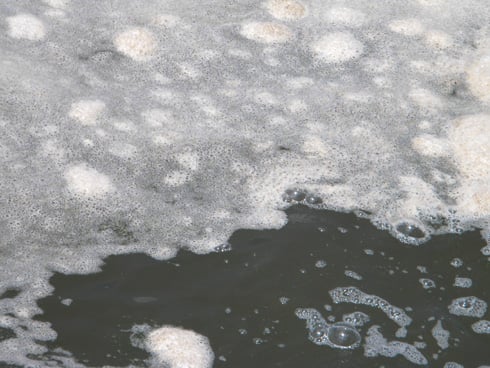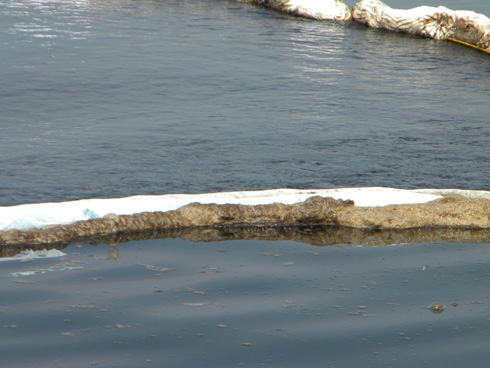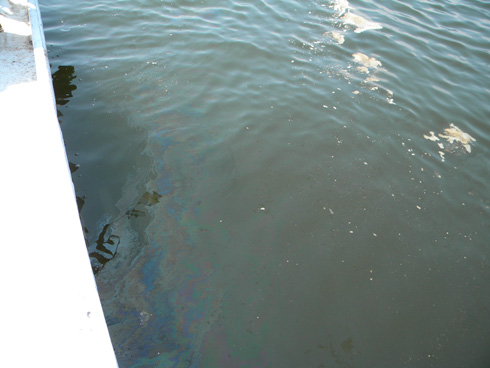"The first thing I noticed, was the 'trail' the boat was leaving in the water," her log from July 10 reads. "You could see exactly where we had been, as far back as you could see. Around 11:00, we were in oil sheen and brownish clumps. We were North of Cat and Ship Island when the Coast Guard told us to drop the boom over. When you pick the boom up, you have to wear 'protective gear.'"
Her log from August 1 describes, in detail, an incident of the Coast Guard not allowing them to collect oil and his proceeding to deny what they found was even oil:
"Around 2:00 p.m., we started noticing a lot of oil sheen. We were North of the East end of Cat Island, but South of the Inter Coastal channel. There was, as usual, a Coast Guard on one of the boats in our team. He called in to report it, but we were told not to drop the boom, it was just 'Fish Oil.' In the beginning of the clean-up operation, if something was floating on the water and it looked like oil, it was oil or oil sheen. Later they would sometimes say it was just 'Fish Oil.' Also, if it was heavy foam with a brown or rust color, originally it was 'Oil Mousse.' Later it was called 'Algae.' We were then told to head Northwest. The further we went, the worse the 'Fish Oil' got. Then, the foam was mixed in with the oil. It was at least the size of a football field, around our boat alone. My husband got on the radio and asked if they could put the boom over." The Coast Guard, again, told them no. "We were then headed West, back towards Pass Christian. A pleasure boat flagged one of the boats in our group down and told him that there was oil all over. The Coast Guard said to tell him that they were aware of the situation ... On the way back to the Pass Harbor, I asked my husband, 'Just exactly what are we even doing out here?' He told me that he was beginning to think that it was all just for show. I can only imagine what the people on the pleasure boat had to say when they got back home that day. Probably, that they had seen a lot of oil on the water and the VOO boats were out there just riding around in it and not doing anything to clean it up. That is exactly what happened. We decided then to start documenting as much as we could. I believe it was the very next day, Thad Allen was on TV saying that they were scaling operations back due to the fact that, 'No oil has been seen in the Gulf in almost two weeks.' Now, if we had pulled boom on Sunday and unloaded a bunch of dirty boom in the Pass harbor, it might have been a problem for him later."
Dispersant remnant, June 26, 2010. (Photo: Shirley Tillman)
On August 5, she describes a rare instance of their being allowed to drop boom in order to collect oil. "We had a Coast Guard and two Safety Men on our boat. We went to the West of the Pass Harbor. The water looked black in places. Lots of bubbles, not foam, just bubbles. Around 8:30, we were in oil sheen and mousse and were told to drop the boom. The more we pulled the boom, it appeared the more was coming up. The Pass [Christian] Harbor was closed because the oil was coming in so bad. We pulled boom back and forth the rest of the afternoon."
-
Oiled boom, August 5, 2010. (Photo: Shirley Tillman)
-
Oil sheen and dispersant remnant, August 1, 2010. (Photo: Shirley Tillman)
By early August, the total number of VOO boats operating out of Pass Christian Harbor, where Shirley and Don worked, was down to 26.
On August 8, Shirley wrote, "talk at the harbor was that airplanes were spraying dispersants on the water at night, out by the islands. There was also talk of skiffs, from Louisiana, with white tanks on them, that were spraying [dispersants] too. We had seen the skiffs before. They would pass us up in the mornings and head towards the Bay St. Louis Bridge. We were told that they were working out of an area at Henderson Point. Henderson Point has a county-owned area with a boat launch & piers. It was closed to the public after the oil spill and a BP sub-contractor staging area was set up. It always appeared that these boats were finishing up their work day, just as we were going to start ours. Most of these skiffs were Carolina Skiffs."
Later that same morning, Shirley and her husband headed out of the harbor with a member of the National Guard on their boat, heading west, while a member of the Coast Guard and another member of the National Guard were on another boat in their VOO team. After boating for an hour, they turned back to the east, at which point Don spotted five of the Carolina Skiffs.
"I got my camera and started taking pictures of them," Shirley writes. "As I was zooming in as close as I could, I saw one of them spraying something onto the water. I did not get a picture of it, I was too busy telling my husband to tell the Coast Guard on the other boat. The skiffs had turned North and were scattered out, zigzagging South of the train bridge. The Coast Guard called the incident in and sent one of our boats to follow the skiffs. The skiffs immediately left. When I saw the boat spraying, it was upwind from our boat. Within a few minutes, my nose started drying out. Later my throat and eyes did the same thing. A Coast Guard helicopter was dispatched along with a Coast Guard boat. We saw the helicopter about twenty minutes later, but I never saw the Coast Guard boat."
Back at Pass Christian Harbor, her team reported the Carolina Skiffs actively spraying dispersants. She was told by the contracting company, Parson's, that managed their VOO team, to bring in her photographs.
Her entry from the next day, August 9, reads:
"I took the pictures, 8x10's to Parson's. A short time later, my husband called and said the Coast Guard wanted me to make a disc of the pictures. I took the disc and turned it over to the Coast Guard. I was told, in the presence of others, that the incident had been investigated and the boats in question had been located at the Henderson Point site. He said that these boats were in the VOO program as skimmer boats, but it had not yet been verified. He said that he had questioned them about spraying something on the water. They told him that if I had seen them spraying anything, they were probably just rinsing out their tanks. He also asked me, 'Don't you think if they were spraying dispersants, they would be wearing respirators?' I told him, 'You would think so, but nothing surprises me around here anymore.' We basically left after that. I knew all they had really wanted was to see exactly what I had gotten pictures of. There is of course the question, 'Why would a skimmer boat need to rinse out his tanks?' If he had been skimming oil, why dump it back over? If he hadn't been skimming oil, what was he rinsing out? I know what I saw and I know how I felt afterwards. I also know that in one of the pictures I took, you can see a helicopter over those boats. BP has spotters looking for oil. Could it be he was telling them where to 'Touch Up' before they called it a day? One thing I did learn from Coast Guard guy that day, evidently these so-called skimmer boats, also have the ability to spray!"
The Tillman's curiosity drove them to investigate
further, given the inconsistencies they were seeing in the Coast Guard's
actions regarding the dispersant being sprayed from contractors in the
Carolina Skiffs.
"My husband came home and said that they had seen the 'Skiffs' again
today," reads Shirley's entry from August 10. "He took pictures of them
and a jack-up-rig. The rig moves around in the sound and is suppose to
be a de-contamination station. However, some Captains have said when
they went there, they were told it wasn't in operation at the time.
After thinking about the tank skiffs and the Coast Guard for two days, I
could not make any sense of this whole situation. The Coast Guard is
supposedly over the VOO Program, but it knows nothing about the skiffs
at the site, so close to the Pass Harbor. They not only tell us every
move to make, but they are always with us when we make the moves. Our
boats are flagged and have transponders on them. Those boats have no
flags, we have not seen a transponder, nor a Coast Guard member on one
of them telling them what to do."
(Note: You can view every article as one long page if you sign up as an Advocate Member, or higher).







